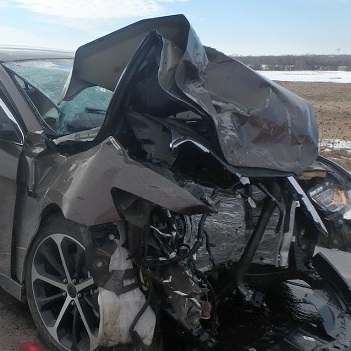A new study has revealed a concerning trend in fatal motor vehicle collisions across the United States. Between 2012 and 2021, certain states have seen a significant increase in fatal crashes involving another vehicle, with Kansas ranking in the top 10.
According to the Journo Research organization, the comprehensive research was conducted by Florida Personal Injury Lawyers Anidjar & Levine, and analyzed extensive data from the National Highway Traffic Safety Administration. The study examined the percentage and number of fatal crashes involving another vehicle in each state, comparing figures from 2012 and 2021 to identify the largest increases.
Among other things, the research found Kansas ranked 9th, with its rate of such crashes increasing from 38.59% to 47.51%, a 23.12% rise.
The top 10 list includes:
- Delaware has emerged as the state with the most significant increase. In 2012, 29.63% of its fatal crashes involved a collision with another vehicle (32 out of 108), which rose sharply to 46.97% (62 out of 132) in 2021. This represents an increase of 58.52% in fatal collisions involving another vehicle over the ten-year period.
- Massachusetts ranks second, with the percentage of fatal crashes involving another vehicle rising from 25.48% (93 in 354) in 2012 to 36.52% (145 in 397) in 2021. This constitutes a 43.35% increase, highlighting a substantial escalation in such incidents within the state.
- Utah follows in third place, showing a 34.35% increase in the same period. There were 63 fatal crashes involving a collision with another vehicle in 2012, which equates to 31.5%. The figure increased to 124 in 293 by 2021, representing 42.32% of all fatal crashes.
- Rhode Island also recorded a notable increase, with the percentage of fatal crashes involving another vehicle rising from 32.26% in 2012 to 42.62% in 2021, which marks a 32.13% increase, placing Rhode Island fourth in the national ranking. The state was one of just nine to see an overall reduction in the number of fatal crashes, going from 62 in 2012 to 61 in 2021 – however the number that involved a collision with another vehicle went up from 20 to 26.
- Mississippi ranks fifth, exhibiting a significant escalation in fatal crashes involving a collision with another vehicle. In 2012, the state’s percentage of such crashes stood at approximately 30.97%, due to 157 out of 507 incidents fitting the criteria. By 2021, this figure had risen to 40.46% (282 in 697), translating to a 30.65% increase over the ten-year period.
- Colorado, at sixth, saw an increase from 33.18% in 2012 to 42.32% in 2021, a rise of 27.55%.
- Arizona, ranking seventh, witnessed its percentage grow from 33.33% to 41.67%, marking a 25.02% increase.
- Nevada, in eighth place, experienced an increase from 30.67% to 38.33%, a 24.98% escalation.
- Kansas, ranking ninth, saw its rate of such crashes increase from 38.59% to 47.51%, a 23.12% rise.
- Vermont, in the tenth position, observed an increase from 28.57% to 34.78%, a 21.74% rise over the ten-year period.
Conversely, the five states at the bottom of the ranking demonstrated a decrease in the percentage of fatal crashes where one vehicle collided with another. Iowa, ranked 46th, saw a decrease from 40.61% in 2012 to 37.69% in 2021, a reduction of 7.18%. New Hampshire, at 47th, experienced a decrease from 30.69% to 28.30%, marking a 7.79% reduction. Maine, in the 48th spot, saw its rate decline from 37.09% to 34.07%, an 8.12% decrease. South Dakota, ranking 49th, experienced a reduction from 38.14% to 33.59%, a 11.93% decrease.
Lastly, Hawaii, at the bottom of the list, saw the most significant reduction from 44 out of 114 fatal crashes (38.60%) in 2012, to 25 out of 95 (26.60%) in 2021, a substantial decrease of 31.09%.
_ _ _
Methodology: The analysis was based on data from the National Highway Traffic Safety Administration, focusing on the percentage and number of fatal crashes involving another vehicle in each state. The study compared data from 2012 and 2021, calculating the percentage increase in such collisions to identify states with the most significant escalation in this period.



